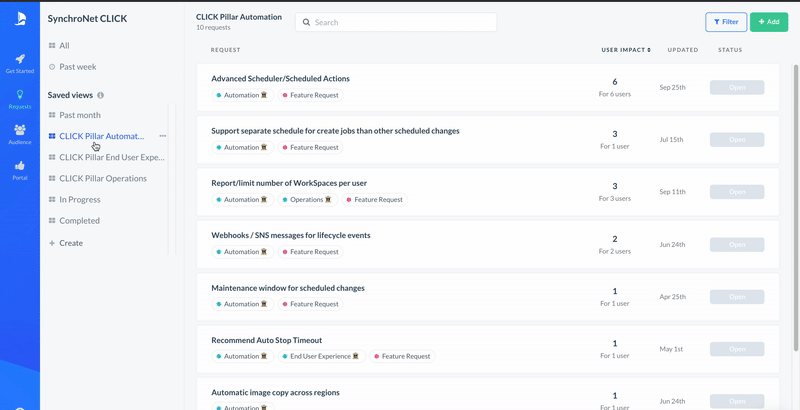Designing processes to close feedback loops and improve user experience as the company scales rapidly
SynchroNet CLICK Process
Design Case Study
Internship: CSAT | Case Study | Feedback Process
Role: Process & CX Designer | Researcher | UX Evangelist
Problem
SynchroNet’s customer base, AWS & AppStream users, and their customers’ remote workforces, have grown exponentially due to the Covid-19 pandemic and the expanding work-from-home (WFH) preference. Because of their deep devotion to customer needs, SynchroNet Click required a process by which they can properly log feedback, hear their customer, and gauge their product roadmap impact based on business growth, in depth user experience, and customer success stories.
Solution
I streamlined the way feature requests are captured to measure the impact of user needs and help guide roadmap development. Additionally, I implemented a process to close the feedback loop by sending a quarterly CSAT/CES survey followed by scheduling voluntary case study/feedback interviews. These conversations bridged the gap between customer pain points and their future goals which gave SynchroNet valuable insight into where they can offer more support and where growth opportunities lie.
Understanding Business Structure
There were two main factors that I took into consideration when consulting on feedback capturing and customer voice:
The first is the actual structure SynchroNet CLICK’s team uses when developing new features and updates to their product. SynchroNet CLICK has adopted the Shape Up methodology. It is a very effective process, and I highly recommend giving Ryan Singer’s book a read if you want to have an in-depth look at how Basecamp designs and develops.
The management team “shapes” ideas first. By defining boundaries and constraints, and acknowledging the risks and rabbit holes.
Next, they “pitch” the idea in a document that outlines the problem, realistic appetite, and solution. This document includes fat marker sketches, the rabbit holes to avoid, to help maintain the scope of the project.
Lastly, the the team then works in 2-week or 6-week cycles to complete their developments. The shaping coming from a higher level leaves flexibility for the development team but enough constraints as to not burn out or have major backlog.
The second important factor was recognizing SynchroNet CLICK’s three pillars that continue to guide the high level importance of their product.
Knowing which of these pillars is out of sync or balance based on customer feedback and feature requests is essential in making sure SynchroNet CLICK is delivering to their customers.
From a business perspective it was also helpful to understand what pillar has the most value to the customer to help guide future sales growth and marketing to their customer based on need.
Feature Request Process
I implemented a process to capture customer and internal feature requests using Shipright. Since our product is for a very specific purpose, it is important to know what features are missing or what could be better based on the customers using it daily. Shipright has become the set-in-stone feature request depository so …
Shipright feature requests organized by CLICK Pillars
In the past, SynchroNet focussed it’s selling point on Automation, but it became clear that what needed the most work and what their customers find valuable is the Operations aspect of CLICK.
I helped to organize each of our feature requests based on what pillar they belonged to. In doing this, we can see what percentage of the requests belong to which pillar and what most people need over what has been successful.
I improved and owned the process of collecting feature requests and quantifying the value of each request.
Quantitative Customer Experience
Receiving feature requests is a really important way that SynchroNet CLICK shapes the roadmap, but that requires the customer to reach out and ask for something. While these conversations are valuable, it is often the loudest customer voice that shapes the roadmap.
Example question useful for funding engagements
In order to get a pulse on the less vocal customers, I designed a quarterly CSAT survey and process to send it through our subscribed email list. At the end of every quarter we send out the survey.
These results can help gauge problems as well as quantify customer satisfaction and user experience overtime. It also became a benchmark of success to showcase for future funding engagements.
At the end of the survey was an optional question asking for willing participants to be included in case study and feedback interviews. Out of the six willing participants we were able to conduct four interviews for the quarter.
Qualitative feedback & Case Studies
Quantitative feedback is great for measuring need and success overtime, but it is limited in providing the full picture of customer experience. Talking with customers directly adds qualitative value needed to fully understand CX.
To prepare for the case studies, I met with our project managers for each customer that agreed to be interviewed.
This helped reveal background information on the account so that the conversation was geared for the specific customer. It also gave provided insight into any loose ends the project managers and sales teams had with the customer so I could ask questions to get a pulse on future opportunities.
I scheduled an hour long recorded session with each customer. I asked questions about their experience from start to finish, where they are still having issues, and what their future state of success looks like.
I created a Confluence page for each customer session with the results, feedback, customer quotes, and any future action items that may be outstanding.
Example of the case study interview capturing for internal use and future marketing








